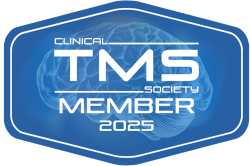
Major depression is one of the most common mental health issues in the US. It affects around 21 million (8%) adults each year. If you’re one of them, you know the feeling—persistent sadness, low energy, hopelessness, and sometimes, even suicidal thoughts. And it gets worse when the depression just doesn’t go away despite treatment.
Often, depression does feel overwhelming, mainly when traditional treatments like antidepressant medication or talk therapy haven’t provided relief. Thankfully, innovative treatments like transcranial magnetic stimulation (TMS) are transforming how depression is treated, especially for treatment-resistant depression.
Understanding TMS
TMS is an FDA-approved treatment that’s rapidly becoming a cornerstone in depression treatment. Unlike invasive procedures, TMS is noninvasive, doesn’t produce systemic side effects, and doesn’t involve surgery or sedation. During treatment, a specialized magnetic coil within a helmet gently rests on your head, delivering magnetic pulses directly to specific areas of the brain. These pulses stimulate brain cells linked to mood regulation, significantly reducing symptoms of depression.
The technology behind TMS resembles magnetic resonance imaging (MRI), but instead of imaging your brain, these magnetic pulses stimulate and activate regions responsible for mood regulation. TMS specifically targets the prefrontal cortex, a critical area of the brain associated with mood, emotion, and decision-making.
Why TMS is Gaining Popularity
The United States Food and Drug Administration approved the first TMS for major depressive disorder in 2008 – and the technology has been a game changer. Clinical trials show impressive success rates, with up to 80% of people experiencing significant improvement in depression symptoms and about two thirds of participants achieving complete remission. This level of effectiveness is remarkable, especially considering these people have typically exhausted traditional treatments.
Another reason it’s gaining popularity is it doesn’t cause memory loss or cognitive impairment, which are often concerns with other procedures like electroconvulsive therapy (ECT). Patients undergoing TMS report minimal side effects, usually limited to mild discomfort or temporary headaches, which typically fade quickly after sessions.

Who Can Benefit from TMS?
TMS is beneficial if you’ve tried traditional antidepressant medications or talk therapy without success. If you’re struggling with persistent depression symptoms despite other treatments, TMS provides a promising solution. Furthermore, if you’ve experienced intolerable side effects from medications like a diminished libido, weight gain or others, TMS could be a safer alternative with fewer risks.
TMS is also utilized in treating related diagnoses such as OCD, anxious depression and even for adjunctive treatment in smoking cessation. As research continues to evolve, there is growing optimism about the broader applications of TMS in mental health care.
What to Expect During TMS Treatment
A typical TMS treatment session is designed with patient comfort and convenience in mind. Here’s a brief overview of what you can expect:
Preparation and Setup
Before your session begins, you will be seated in a comfortable chair at a medical center specializing in TMS. The technician will position the helmet on your head, guided by measurements or, in some cases, magnetic resonance imaging data to precisely target the correct brain area.
The Stimulation Process
During the session, the TMS machine delivers short bursts of magnetic pulses. You may hear clicking sounds as the coil activates and feel a light tapping sensation on your head. These sensations are normal and tend to fade as you become accustomed to the treatment.
Post-Session Experience
Since TMS is noninvasive and does not involve anesthesia, you can resume your daily activities immediately following the session. Many patients appreciate that they do not require transportation home or an extended recovery period, which allows them to continue work or family responsibilities with minimal disruption.
Treatment Course
At Relief, TMS is typically administered in 36 sessions—five days a week for the first six weeks, three times during the seventh week, twice during the eighth week and once at nine weeks. Each session lasts approximately 20 minutes. The exact number of sessions will depend on the specific treatment protocol your provider recommends. Some emerging accelerated protocols explore the possibility of delivering multiple sessions daily to shorten the overall treatment period while maintaining effectiveness.

The Role of Clinical Trials and Ongoing Research
Clinical trials have played a crucial role in establishing the efficacy and safety of TMS. Numerous studies have documented significant improvements in depression symptoms following TMS treatment, leading to its FDA approval for major depressive disorder. Researchers continue to explore optimal stimulation parameters—such as frequency, pulse intensity, and the precise targeting of areas of the brain—to maximize the benefits of TMS.
Recent clinical trials have even compared TMS with other treatment modalities, such as electroconvulsive therapy (ECT). While ECT remains an effective treatment for some, many patients opt for TMS because it offers a noninvasive alternative with fewer cognitive side effects. Moreover, ongoing research is investigating the long-term benefits of TMS, including how often maintenance sessions may be required to sustain improvements in mood and functioning.
Advancements in neuroimaging techniques like MRI, are also helping clinicians better understand which areas of the brain are most involved in depression symptoms. Such data makes it possible to personalize TMS treatments to each patient’s brain structure and clinical needs.
Insurance Coverage and Accessibility
Many health insurance plans cover TMS therapy, but the coverage varies based on specific criteria set by your insurance provider, such as:
- Age requirements (e.g., being 18 or older).
- Documented history of treatment-resistant depression, including unsuccessful trials of antidepressant medications and psychotherapy.
Talk to your insurance provider to understand what it covers and what it doesn’t. You can also get help from our team at Relief Mental Health. Relief is in-network with most private insurance companies, as well as Medicare and Tricare.
We will work with you and your insurance company to find the best way to get the most out of your coverage. We’ll also help you determine your eligibility for TMS, verify your insurance benefits, and advise you on payment options.
Get TMS at Relief Mental Health
We are a leading provider of TMS therapy in the U.S. We have multiple locations across Illinois, New Jersey, Wisconsin, and Colorado to ensure you get access to personalized care. If you’re seeking a new approach to managing depression, TMS at Relief Mental Health could be the solution you’ve been looking for. Contact us today to learn more and take the first step toward relief.

